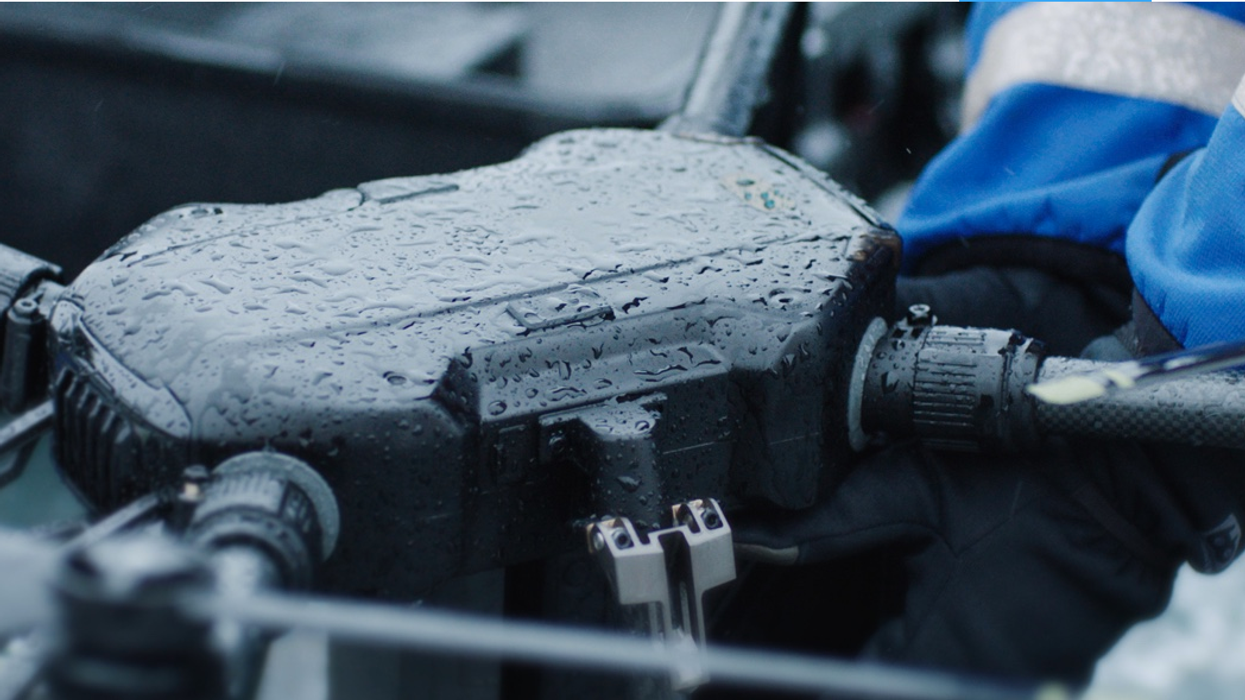DJI Announces Extreme-Weather Matrice 200 Series Drone
The Matrice 200 Series from DJI is designed for flights in extreme terrain and adverse weather conditions.

Today, DJI announced their brand new line of Matrice drones–the Matrice 200 Series. Designed to be flown in extreme terrain and adverse weather, the Matrice 200 Series can make life easier for filmmakers shooting in less than ideal conditions. While the DJI Matrice 200 Series seems to be aimed at industrial and enterprise users, like those doing powerline inspections, search & rescue, and offshore oil rig inspections, the increased flight times, weather resistance, and increase payload capacity may certainly be features welcomed by filmmakers.
The Matrice 200 Series features a dual-battery system capable of flight times of up to 32 minutes (actual flight times determined by payload, of course). In addition, the dual-battery system is also capable of heating the batteries to keep them from reaching dangerously cold temperatures when flying in sub-zero weather.
To help power through adverse weather conditions, the Matrice 200 features IP-43 Ingress Protection (which is a more specific definition of how "waterproof" something is) which keeps the sensitive internal components safe from water, dust, and particles. This means you can now fly in inclement weather conditions that would previously have been prohibitive to flight.
The flight autonomy system as well as the obstacle sensing capabilities of the Matrice 200 Series have been improved, too. Now featuring a "Time of Flight Upward Facing Laser System," the Matrice 200 Series has the ability to detect objects directly above it, beneath it, and in front of it thanks to its stereo-vision camera. In addition, DJI is claiming "centimeter level positioning accuracy" thanks to the RTK GNSS GPS technology. Beyond that, the Matrice 200 Series seems built to better withstand electromagnetic interference making it more stable in the air when working in areas with large metal structures and electromagnetic interference. The sense-and-avoid capabilities are welcomed features for safe flying.
According to the video, it seems as if the Matrice 200 Series will work with many of the existing DJI gimbals (x5s, X4s), and has the capability of mounting two gimbals on it. Now while this doesn't seem to have been designed for 3D, it could be interesting to explore the possibilities for 3D filmmaking.
Tech Specs (M 200)
Airframe
- Package Dimensions 790mm*390mm*290mm
- Dimensions (unfolded) 887mm*880mm*378mm
- Dimensions (folded) 716mm*220mm*236mm
- Folding Method Fold Inward
- Diagonal Wheelbase 643mm
- Number of Batteries 2
- Weight (TB50) 3.80KG
- Weight (TB55) 4.53KG
- Max Takeoff Weight 6.14KG
- Max Payload (TB50) 2.34KG
- Max Payload (TB55) 1.61KG
Compatible Gimbals
- ZENMUSE X4S
- Zenmuse X5S
- Zenmuse Z30
- Zenmuse XT
Gimbal Installation
- Downward Gimbal Mount - Supported
- Upward Gimbal Mount - Not Supported
- Downward Dual Gimbal - Not Supported
Tech Specs (M 210)
Airframe
- Package Dimensions790mm*390mm*290mm
- Dimensions (unfolded)887mm*880mm*378mm
- Dimensions (folded)716mm*220mm*236mm
- Folding MethodFold Inward
- Diagonal Wheelbase643mm
- Number of Batteries2
- Weight (TB50)3.84KG
- Weight (TB55)4.57KG
- Max Takeoff Weight6.14KG
- Max Payload (TB50)2.3KG
- Max Payload (TB55)1.57KG
- Hovering Accuracy (during safe flights)Vertical: ±0.5,Downward Vision System enabled: ±0.1
- Horizontal: ±1.5,Downward Vision System enabled: ±0.3
- Max Angular VelocityPitch: 300° /s;Yaw:150° /s
- Max Pitch AngleP Mode: 35°(Forward Vision System enabled: 25°); A Mode: 35°;S Mode: 35°
- Max Ascent SpeedP Mode / A Mode / S Mode: 5 m/s
- Max Descent SpeedVertical: 3 m/s
- Max SpeedS Mode 23m/s P Mode 17m/s A Mode 23m/s
- Max Service Ceiling Above Sea Level1.55 mi (2500 m)
- Max Wind Resistance10m/s
- Max Flight Time(No Payload, with TB50)27min
- Max Flight Time(No Payload, with TB55)38min
- Max Flight Time(6kg Payload, with TB50)13min
- Max Flight Time(6kg Payload, with TB55)24min
- Motor ModelDJI 3515
- Propeller Model1760S
- Landing GearQuick-release
- Operating Temperature-20°C to 45° C
- IP RatingIP43
Compatible Gimbals
- ZENMUSE X4S
- Zenmuse X5S
- Zenmuse Z30
- Zenmuse XT
Gimbal Installation
- Downward Gimbal Mount - Supported
- Upward Gimbal Mount - Supported
- Downward Dual Gimbal - Supported
Tech Specs (M210 RTK)
Airframe
- Package Dimensions790mm*390mm*290mm
- Dimensions (unfolded)887mm*880mm*408mm
- Dimensions (folded)716mm*242mm*236mm
- Folding MethodFold Inward
- Diagonal Wheelbase643mm
- Number of Batteries2
- Weight (TB50)4.27KG
- Weight (TB55)5.0KG
- Max Takeoff Weight6.14KG
- Max Payload (TB50)1.87KG
- Max Payload (TB55)1.14KG
- Hovering Accuracy (during safe flights)Vertical: ±0.5,Downward Vision System enabled: ±0.1
- Horizontal: ±1.5,Downward Vision System enabled: ±0.3
- Max Angular VelocityPitch: 300° /s;Yaw:150° /s
- Max Pitch AngleP Mode: 35°(Forward Vision System enabled: 25°); A Mode: 35°;S Mode: 35°
- Max Ascent SpeedP Mode / A Mode / S Mode: 5 m/s
- Max Descent SpeedVertical: 3 m/s
- Max SpeedS Mode 23m/s
- P Mode 17m/s A
- Mode 23m/s
- Max Service Ceiling Above Sea Level1.55 mi (2500 m)
- Max Wind Resistance10m/s
- Max Flight Time(No Payload, with TB50)23min
- Max Flight Time(No Payload, with TB55)32min
- Max Flight Time(6kg Payload, with TB50)13min
- Max Flight Time(6kg Payload, with TB55)24min
- Motor ModelDJI 3515
- Propeller Model1760S
- Landing GearQuick-release
- Operating Temperature-20°C to 45° C
- IP RatingIP43
Compatible Gimbals
- ZENMUSE X4S
- Zenmuse X5S
- Zenmuse Z30
- Zenmuse XT
Gimbal Installation
- Downward Gimbal Mount - Supported
- Upward Gimbal Mount - Supported
- Downward Dual Gimbal - Supported
For full tech specs visit DJI's website.
Source: DJI














